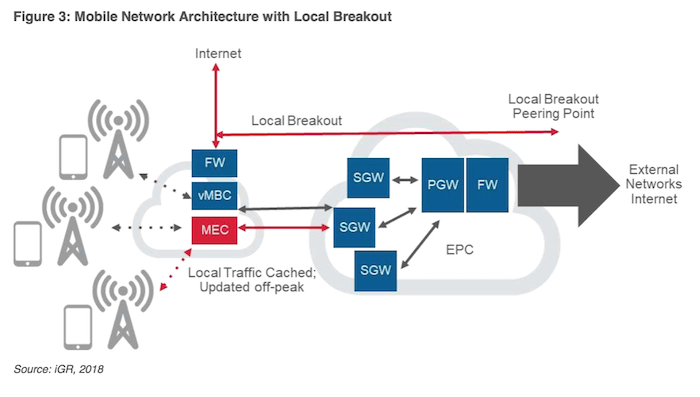As net neutrality appears in U.S. news again, a product in trials now could ease carriers’ financial issues in the fight. It could also help justify investing in the 5G stepping stone mobile edge computing (MEC).
Mavenir estimates that U.S. mobile carriers can save $546 million over a five-year period by offloading traffic — mostly video — onto the Internet. A study commissioned by Mavenir shows these results after offload 32% of video traffic, for a carrier with 50 million subscribers.
Research firm iGR estimates that 80 percent of traffic on a network today is from video.
“If you think they are carrying 80 percent of the traffic and not getting a penny for it, no wonder these guys [CSPs] are struggling to make their businesses profitable,” John Baker, SVP of business development at Mavenir told RCR Wireless News at the 5G North Americas/New Horizons event in Austin, Texas.
Mavenir, which offers network-improvements via Cloud-based software to CSPs (communication service providers), commissioned iGR to produce the study as way to build a business case for its virtualized Media Breakout Controller (vMBC) product out on trials now. The vMBC, which Mavenir announced in January, enables a network operator to offload heavy, unprofitable traffic such as encrypted video, to the Internet.
Along the way, the product could help justify installing the MEC.
“We are at that next stage now, to make a business case for it,” said Baker. Within the cost analysis in the business case (iGR’s report), Mavenir put in the cost of adding an edge server for MEC.
The vMBC derives from Brocade’s virtual evolved packet core (vEPC) product line, which Mavenir purchased last year. Mavenir said it would use Brocade’s vEPC technology to improve next-generation core network services, providing a path toward 5G and edge computing.
“Allows you to disaggregate the traffic away from the core and then improve the cost efficiency of the network so, you are not carrying the traffic the content. It is traffic that has no value to the operator,” said Baker.
vMBCs can be used anywhere in the network but is better closer to the edge. The controller enables operators to augment and extend their existing gateway products.

A MEC (mobile edge computing) unit can be placed anywhere between the baseband unit and the EPC. The MEC server can also be used to breakout local Internet traffic at the cellular base station. In this application, the MEC is configured as a virtual EPC and provides traffic routing functions to recognize and direct traffic that can be broken out immediately to the Internet. All the traffic from the local cell towers is routed through the MEC running the vMBC application, which then decides if the traffic should be backhauled to the EPC or broken out to the Internet. Traffic for the Internet is therefore routed immediately, through a firewall, to a dedicated Internet link and if necessary tunneled to a local peering point. This traffic is therefore not routed through the EPC and thus the backhaul and EPC load is reduced. (Caption and image courtesy of iGR report, Mavenir)
“40% of that 80% of traffic is encrypted video. From a carrier perspective, it is just going straight over the top, but they have to provide all the capacity and the elements to carry this stuff. If you could offload at least the encrypted piece, which is the least valued piece first, then you know how much money you can save in the core of the network. You save it in transport, licensing cost, network elements all the way through the network and then you start to enable some of these edge computing type scenarios,” said Baker.
The global cost savings could help justify installation. iCR reports $546 million savings in the U.S. (50 million subscribers over 5 years), €189 million in Germany (30 million over 5 years), $106 million in Australia (10 million subscribers over 5 years), and in India, 38,764 million Rs (150 million subscribers over five years).
“If the carriers could charge for some of this stuff, they would start to become more profitable,” said Baker. “Obviously they are making some money on certain video functions. They are working with certain TV companies to provide content. But with this whole move in the wider industry to go to IPTV, you know — I am going to stream my programs wherever I am and whenever I want. The days of set-top box are sliding away to apps on phones that will stream video.”
The post Pushing video traffic off networks could save $546 M, justify MEC appeared first on RCR Wireless News.
